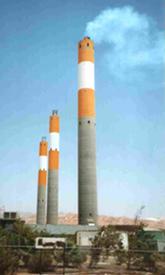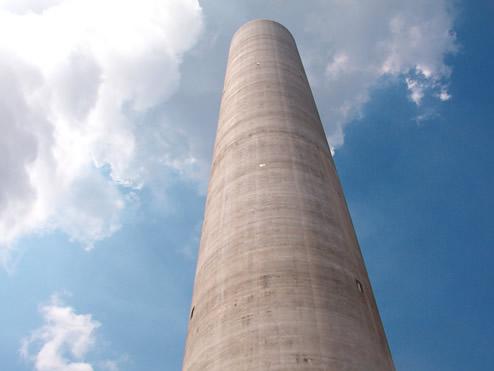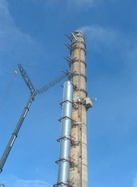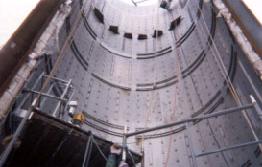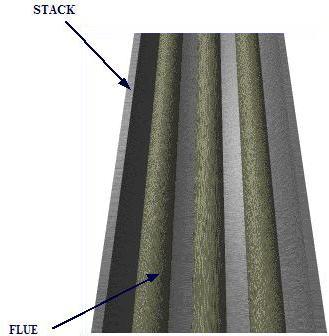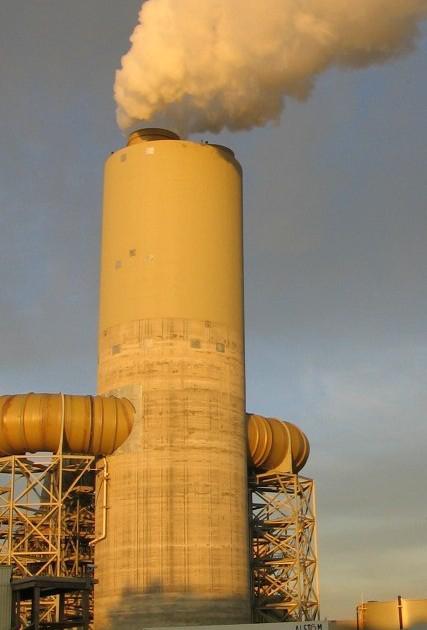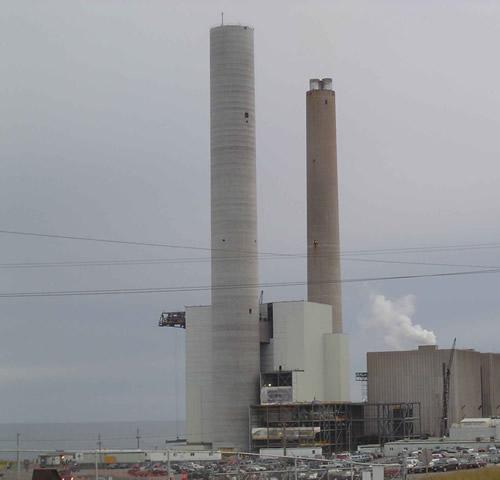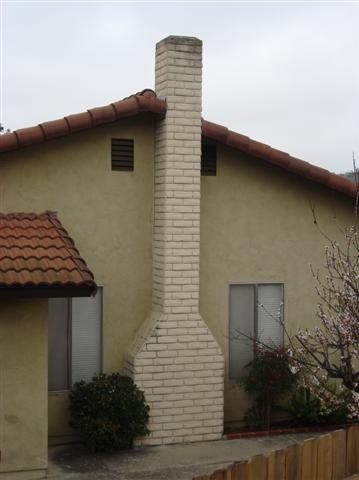Chimneys release flue gases into the atmosphere to reduce ground-level concentrations.
General Information
The earliest chimneys began to emerge at the start of the industrial revolution. They were built of cut stone and had extremely thick walls. The first concrete chimney, made of sand mortar and cement, was built in 1873, near Sunderland, England. It was 62 feet tall and had no internal lining to protect the concrete.
These early chimneys were nothing more than stone or brick towers and often cracked or collapsed. Today, chimneys are much taller and include reinforced concrete and linings so they are better able to handle environmental and flue gas stresses.
Equipment Design
Chimneys are built using either precast or cast-in-place concrete blocks. The blocks typically contain vertical and horizontal steel reinforcements. These steel reinforcements protect the concrete from heat damage, such as cracking, that the hot gases can cause. The picture on the left shows a concrete chimney being renovated with steel reinforcements. The picture on the right shows the inside of a steel-reinforced chimney. This chimney is reinforced to help vibration and corrosion control.
Precast sections are typically no more than 14 feet tall and are hoisted into place and fastened together. Precast chimneys can be up to 240 feet tall.
Chimneys contain one or more flues, as the three flue chimneys in the schematic below to the left show, through which the stack gas travels. Each flue is insulated and lined to protect the concrete stack. Linings can be made of brick, steel, and occasionally glass-reinforced plastic. The lining must be resistant to abrasions and chemicals, primarily sulfuric and hydrochloric acid that can condense.
The air gap between the lining and the stack, or windshield, typically serves as the insulation for single flue chimneys. Multi-flue chimneys commonly use mineral wool, insulating brickwork, foamglass, or glass fiber as insulation. The insulation helps protect the stack from heat damage.
(Copyright Ashland Inc., Covington, KY)
Chimneys are topped with a capping unit that caps the lining and the windshield. The capping unit is made of durable cement containing high amounts of alumina because it is located at the point where the flue gases are most likely to condense to form corrosive acids. Most chimneys include pollution and odor control systems, including electrostatic precipitators, mist eliminators, and wet scrubbers. These reduce the amounts and types of by-products that are vented into the atmosphere. The picture above to the right is an example of a chimney that has a fiberglass reinforced plastic liner and scrubbers to help with pollution control.
Usage Examples
Chimneys are used whenever a combustion reaction takes place. Chimneys release the flue gases into the atmosphere, reducing the ground concentration of potentially harmful gases. Chimneys can be found on all hydrocarbon-burning power plants, as well as many waste treatment plants. They often include pollution or odor minimizing technology to reduce the amount of harmful chemicals released into ambient air.
Chimneys are found on many homes, particularly in cold climates. They serve as a vent for the gases and smoke produced from the combustion of wood in fireplaces.
Advantages
- Reduce ground levels of emissions.
- Provide a safe outlet for hot flue gas.
Disadvantages
- Vent potentially harmful gases into the atmosphere.
- Acids formed by flue gas corrode and destroy flues and stack, requiring periodic replacement.
Acknowledgements
- Alpha Specialist Contracting Ltd., Daventry, Northants, UK
- Ashland Inc., Covington, KY
- Hamon Corp., Somerville, NJ
- Swede Chimney Sweep, San Diego, CA
References
- Haupert, Laura. “Odor Issues and Solutions for Wastewater Treatment”. Chemical Engineering. September 2017: 39-42.
- Pierce, Robert R. “Lining a Chimney.” Concrete International: Design and Construction. Nov. 1987: 44-48.
- Pinfold, Geoffrey M. Reinforced Concrete Chimneys and Towers. London: Cement and Concrete Association, 1975. Print
- “Chimney Systems.” Heating and Air Conditioning Journal 56 Jun 1986: 17-20.
- “Unusual, Precast Concrete Chimneys” Indian Concrete Journal 62 March 1988: 112-115.
Developers
- Daniel Viaches
- Keith Minbiole
- Emma TerBeek

